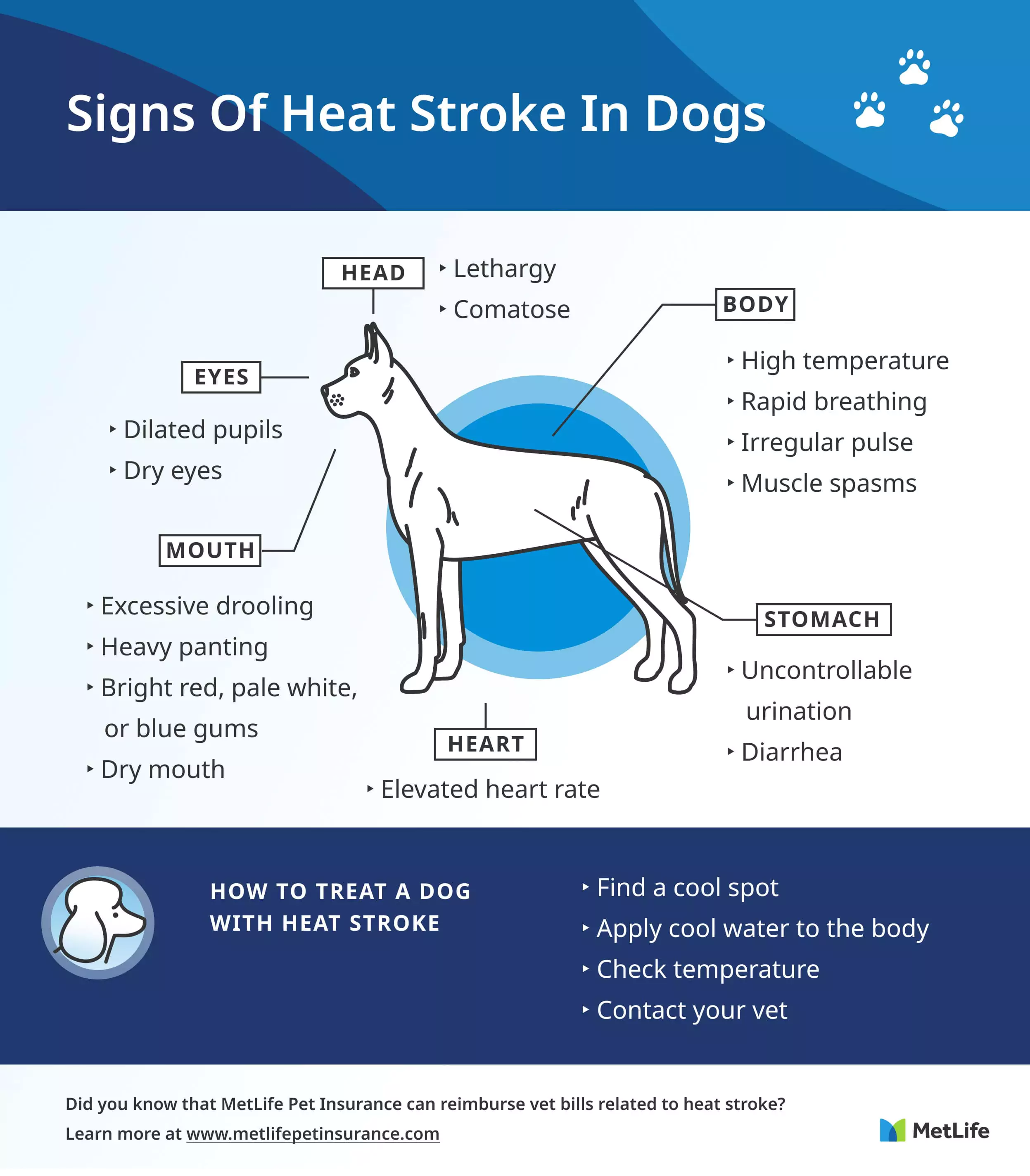Dogs can be loving outdoor companions. They often love hiking, running, and picnicking with us throughout the spring and summer — but the heat could get dangerous for our furry friends. When a dog’s internal body temperature rises above a normal temperature of 101.5℉ (39℃), this is usually classified as hyperthermia. Heat stroke, however, typically occurs when their body temperature skyrockets above 105℉ (41℃).¹ It becomes difficult for dogs to dissipate heat once these temperatures are reached, which in extreme cases, can lead to health complications.
It’s important for pet parents to know the signs of heat stroke, the precautions to take during the warmer months, and how pet insurance could help you in an emergency.
What Are the Signs and Symptoms of Heat Stroke in Dogs?
First, you should know that dogs don’t manage heat the same way humans do (by sweating). Dogs keep themselves cool by panting and expanding their blood vessels — a process called vasodilation — in their ears and faces.¹ When a dog pants, moisture evaporates from their tongue, nose, and lungs to cool the air they breathe. Dogs can sweat from their paws, but that doesn’t help much in cooling off the rest of their bodies.1
As a result, dogs can be susceptible to heat stroke. If you notice your dog panting heavily, be sure to offer them some cool water to drink or ice cubes to lick. Heat stroke in dogs can be a serious medical emergency. Early intervention is key in protecting your dog from the worst effects of heat stroke.
The earliest symptoms of heat stroke in dogs are:¹
- Excessive drooling
- Bright red gums
- Heavy panting
- Rapid breathing
- Dry nose, eyes, and mouth
- Elevated heart rate
Some dogs may become hyperactive or have issues maintaining their balance. Excessive heat can send your dog into shock. Signs of shock from heat stroke include:¹
- Pale white or blue gums
- Hyperventilation
- Dilated pupils
- Irregular pulse
- Muscle spasms
- Lethargy
- Uncontrollable urination or defecation
- Fainting
These symptoms are very scary and require immediate medical attention at an emergency veterinarian, which can be costly.
Pet Insurance May Help Cover Treatment Costs for Heat Stroke
Dog Heat Stroke Treatment: 3 Steps to Take
If your dog is showing any of the symptoms of heat stroke, it’s best to act quickly and try to cool them down. Try these steps:1
- Move to a cool area: Get your dog to a well-ventilated, cool space — preferably with air conditioning.
- Apply cool water: Spray or sponge your dog with cool, tepid water on their underside. Don’t put them in a cold bath, as it’s best for the dog’s internal temperature to gradually cool rather than be shocked from instant cold.
- Monitor temperature: Observe your dog, and take their temperature if you have a rectal thermometer. If you don’t, feel their skin to see if it's hot to the touch.
Retake their temperature every few minutes until it's at 103°F (39℃) if you can. Don’t allow your dog’s body temperature to drop below 103°F because this can lead to further complications.¹
How do vets treat a dog with heat stroke?
It’s advised to call your vet once you’ve finished giving your dog first aid and tell them what’s going on. Severe symptoms may require hospitalization, while milder cases may only require follow-up care. Dogs with severe cases of heat stroke may need to be monitored overnight while they’re given intravenous (IV) fluids, oxygen, and other medications to stabilize their vitals.1
Even mild cases of heat stroke shouldn’t be taken lightly. Dogs who experience heat stroke are likely to experience it again, so it's important to work with your vet to ensure your pet’s individual needs are met.¹ As a pet parent, it’s recommended to monitor your dog and take steps to prevent heat stroke during the hottest days of the year.
How to Prevent Heat Stroke in Dogs: Essential Tips
There isn’t much pet parents can do about the temperature outside, but preventing heat stroke is very straightforward. First, talk with your vet about your pet’s medical history. The American Veterinary Medical Association (AVMA) advises dog parents to prepare safety plans during vacation travel and day trips, like locating or creating spots where your dog can cool off and drink water.²
Let’s walk through some methods that could prevent your dog from getting heat stroke during day-to-day life.
Avoid heat exposure
Consider rearranging your dog walking routine so you aren’t outside during the hottest parts of the day. This may mean early morning and evening walks to avoid hot sidewalks and sweltering temperatures. If you’re out during the day, be sure to provide your pup with plenty of shade to lay down in and fresh water. Pack a bottle of water and a bowl just for them to drink from, especially if you don’t have access to a fountain.
Your dog’s risk of having a heat stroke depends on how high the temperature and humidity are outside, plus your pet’s age and body size. Similar to humans, very young, older, and obese dogs are more likely to have a heat stroke.1 Temperatures below 70°F (21℃) typically don’t pose a risk to most dogs, but temperatures in the upper-70s and above can be life-threatening.3 In higher temperatures, it’s best to avoid long walks and trips to the dog park altogether.
Keep dogs cool and comfortable
Avoid leaving your dogs in hot areas unsupervised.1,2 Places like cars and garages aren’t properly ventilated, so temperatures can easily exceed 100°F (38℃). Consider setting up “cool temperature zones” in your home while you’re at work.² These areas could have a fan, cooling pad, or a pet fountain where your dog can chill.
Pet parents could also consider investing in frozen dog toys and treats.3 Since dogs use their mouths to regulate heat, these sorts of treats can be a good way to keep your pet comfortable.
Watch certain dog breeds and their health conditions closely
Some dogs can be more susceptible to heat stroke than others. Brachycephalic dog breeds have short snouts and flat faces that make regulating heat difficult. This group of dogs includes boxers, pugs, American bulldogs, shih tzus, and cavalier King Charles spaniels.3
Keep in mind that puppies and senior dogs can be more at risk of experiencing heat stroke.¹ Senior dogs are likely to have pre-existing conditions, such as heart disease, that can make managing their body temperature difficult. It’s best to work with your vet on how best to care for your puppy or older dog to prevent heat stroke.
Lastly, pets who are overweight or obese can be more likely to suffer during warm months.¹ The excess weight can make moving around and keeping cool difficult. It’s best to work with your vet to get them back to a healthy weight, so they’re less at risk of heat stroke and other weight-related issues.
MetLife Pet Insurance Is Ready for the Dog Days of Summer
With warm weather comes fun days and plenty of time outside. Your dogs are likely to be there every step of the way, so it's important to be prepared.
Even with pet parents doing their best, accidents can happen, which could lead to expensive vet bills. With MetLife Pet’s dog insurance policies, pet parents can save money on the cost of hospitalization, medication, and other necessary treatments. By choosing pet insurance, you can focus on your pet's recovery rather than the price. Get started with a free quote today.
We Can Help Cover Vet Bills While You Focus on Your Dog’s Care
855-270-7387



